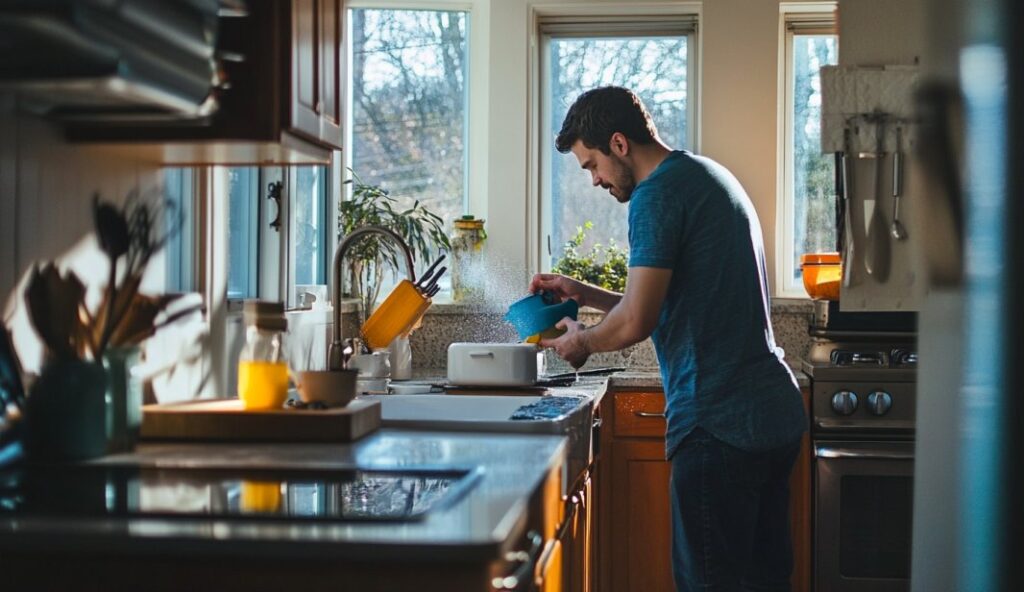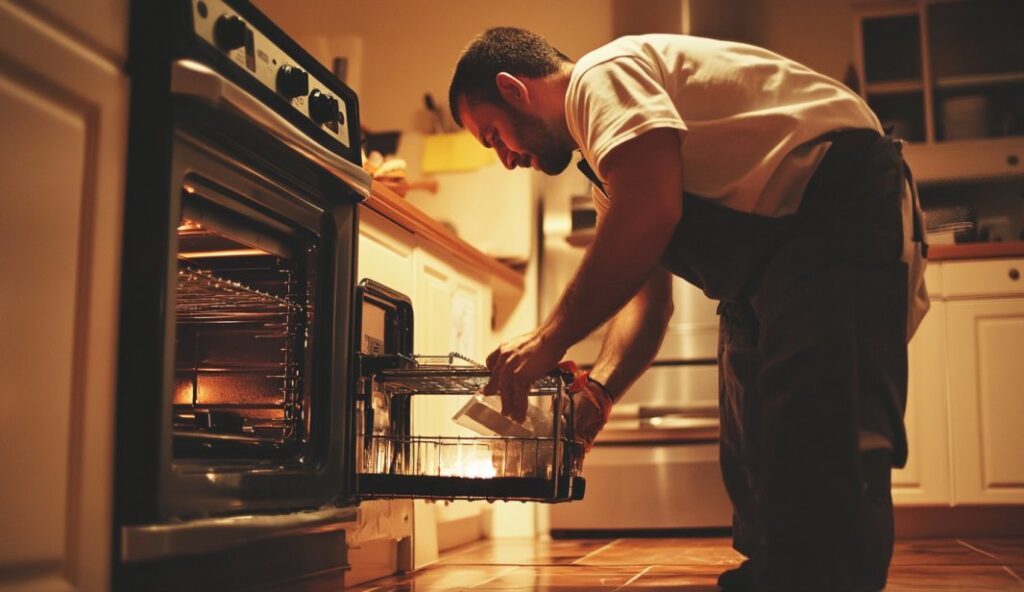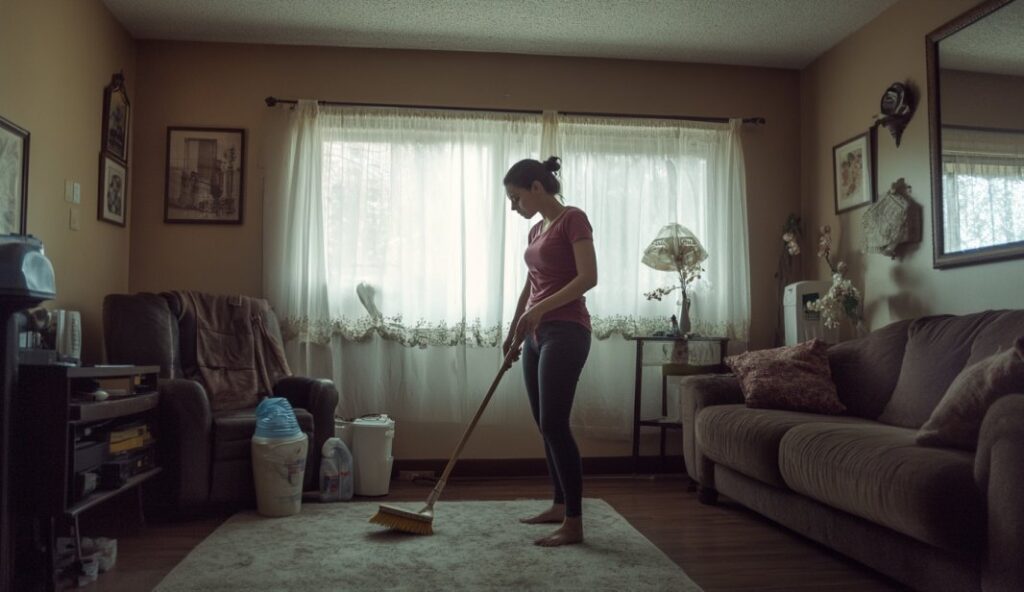 When we clean our homes, we tend to focus on the most obvious spots—the countertops, floors, and visible surfaces…
When we clean our homes, we tend to focus on the most obvious spots—the countertops, floors, and visible surfaces…
However, there are many hidden areas that often get overlooked but can accumulate dirt, germs, and grime just as quickly, if not faster. These “invisible” spots, which include the undersides of tables, door handles, and even inside appliances, play a significant role in the cleanliness and hygiene of our homes. If these spots are left unchecked, they can negatively affect not just the appearance of your space but also its overall health and safety. In this guide, we’ll uncover some of these overlooked areas, explain why they need attention, and provide simple solutions to help keep your home truly clean.
Commonly Overlooked Areas
Underside of Tables and Chairs
The underside of tables and chairs is one of the most common places that are often forgotten when cleaning. It's easy to wipe the visible surfaces, but the undersides tend to accumulate dust, crumbs, and sticky residues that can go unnoticed for weeks. The worst part? These areas can be a breeding ground for bacteria, especially if food is regularly dropped during meals or snacks.
Why does this happen? It's simple: these spots are often hard to reach, and most people don't have the time or patience to flip over every chair or crawl under the table to clean. But the truth is, dirt builds up quickly, and ignoring it can eventually make your furniture look grimy or worn out.
The good news is that this is an easy fix. Simply use a handheld vacuum or a microfiber cloth to clean underneath your tables and chairs regularly. A quick dusting will go a long way in keeping these areas clean and sanitary.
Door Handles and Light Switches
Door handles and light switches are high-touch areas that people often overlook, but they can harbour a surprising amount of germs and bacteria. Think about how many times a day you touch these surfaces, then consider how often they’re actually cleaned. The truth is, we tend to focus on more visible parts of the home and forget that door handles and switches are constantly being touched by everyone in the household, making them hot spots for germs.
While it might seem like a small thing, neglecting to clean these spots can lead to the spread of bacteria and viruses around your home. To avoid this, wipe down door handles and light switches with a disinfecting wipe or a clean cloth soaked in a mild cleaning solution at least once a week. Doing this regularly can drastically improve the overall hygiene of your home.
Inside Appliances
When was the last time you cleaned inside your oven, cooktop, rangehood, or BBQ? Most people think of cleaning these appliances only when they get visibly dirty or when they start to smell, but regular maintenance is key to keeping them in good working order. We talked with the guys at Optima Cleaners https://optimacleaners.com.au/oven-and-bbq-cleaning/sydney/, and they emphasised how important it is to stay on top of cleaning these appliances, as neglecting them can lead to bigger issues down the line. Regular upkeep helps prevent the build-up of grease, food residue, and other debris that can affect both the performance and hygiene of your kitchen equipment.
Ovens
Ovens are one of the most commonly overlooked areas when it comes to cleaning. It's easy to forget about the grease and food splatters that build up on the interior walls of your oven, especially if you use it regularly. However, not cleaning the oven can lead to unpleasant odours, uneven cooking, and even safety hazards, as grease and food remnants can catch fire.
To maintain your oven, give it a deep clean every few months. Start by wiping down the walls with a damp cloth after each use to prevent build-up. For a more thorough cleaning, use an oven cleaner or a natural solution like baking soda and water to scrub off stubborn grime. Don’t forget to clean the oven racks, as they can also trap food residue.

Cooktops
Cooktops are another appliance that often gets neglected. Whether you have a gas or electric stove, spills and stains are inevitable. Over time, grease can build up around the burners, making your cooktop look grimy and less efficient. Not to mention, spills that aren't cleaned promptly can harden and become difficult to remove.
A simple wipe down after each cooking session can keep your cooktop in good shape. For stubborn grease or food stains, use a non-abrasive cleaner and a soft sponge to avoid scratching the surface. If you have a gas stove, don’t forget to clean the burners and burner caps, as they can collect food debris and grease.
Rangehoods
While rangehoods do a great job of removing cooking smells and steam, they often become a hidden spot for grease and oil to build up. The filters inside the rangehood can clog with grease over time, reducing its effectiveness in ventilating your kitchen. A clogged rangehood can even affect the air quality in your home.
To keep your rangehood working properly, clean the filters monthly. Most rangehood filters can be washed in warm, soapy water, but it’s essential to check the manufacturer’s instructions for specific care. Also, wipe down the exterior of the rangehood regularly to remove any grease that might build up.
BBQs
BBQs are another appliance that tends to accumulate grime, especially after regular use during BBQ season. The grates and burners often have leftover food, grease, and oil that can get stuck if not cleaned properly. If these residues aren’t cleaned off, they can affect the taste of your food and even become a fire hazard.
After each BBQ, make sure to scrub the grill grates with a wire brush while they’re still warm. For a more thorough cleaning, remove the grates and soak them in warm soapy water before scrubbing. Don't forget to clean the burner tubes and drip trays to ensure that your BBQ stays in good condition for longer.
The Impact of Neglecting These Areas
It’s easy to ignore areas that aren’t immediately visible, but neglecting the cleaning of these hidden spots can have serious consequences. Whether it’s affecting your home’s hygiene, causing a build-up of dirt, or even leading to more significant maintenance issues, leaving these areas unattended can affect the overall cleanliness of your home.
Hygiene Concerns
Germs and bacteria thrive in places we don’t often think about, such as the undersides of tables, door handles, and inside appliances. These areas can become breeding grounds for germs, which can then spread to other parts of the home. If left unchecked, they could even contribute to illness in the household, especially in high-traffic areas like the kitchen or bathroom.
Regularly cleaning these spots is a simple and effective way to minimise the spread of bacteria and maintain a healthier living environment. By keeping these invisible areas clean, you reduce the risk of contamination and improve the overall hygiene of your home.
Accumulation of Dirt and Debris
The longer you leave areas like the underside of tables, oven interiors, and cooktops unchecked, the more dirt and debris will accumulate. What starts as a few crumbs under the table can quickly turn into a bigger cleaning job if neglected for too long. Food stains, grease, and grime can build up in appliances and on surfaces, making your home look less than tidy and more difficult to clean.
Regular attention to these areas helps prevent dirt from accumulating in the first place, keeping your home looking fresh and well-maintained. The longer you wait to clean these areas, the harder it becomes to remove the built-up grime.
Long-Term Damage and Maintenance Issues
The longer you allow dirt and grime to build up in hidden spots, the more damage it can cause to your furniture and appliances. For example, food residue in your oven can cause it to overheat, leading to potentially costly repairs. Similarly, clogged rangehood filters or grease-streaked BBQ grills can reduce the performance of these appliances, causing them to work harder and wear out more quickly.
Regular cleaning not only keeps your home looking great but also helps preserve the longevity of your appliances and furniture. By keeping these hidden spots clean, you avoid costly repairs or replacements down the line.
How to Tackle the "Invisible" Spots
Now that we’ve uncovered the hidden areas that often go unnoticed, let’s talk about how to deal with them. Incorporating the cleaning of these spots into your regular routine doesn’t have to be difficult or time-consuming. A few small changes in your cleaning habits can make a big difference in the overall cleanliness of your home. Here are some easy tips for staying on top of these "invisible" spots.
Regular Cleaning Routine
The key to tackling invisible spots is making sure you don’t let them slip through the cracks. Setting up a routine that includes cleaning these areas will ensure they don’t pile up over time. You don’t have to dedicate an entire day to cleaning every single hidden spot—just incorporate a few tasks into your weekly or bi-weekly cleaning schedule.

For example, each time you wipe down your kitchen counters, take a few seconds to clean your cooktop, wipe the light switches, and give the rangehood a quick clean. Similarly, while vacuuming or dusting the furniture, make it a point to quickly check under tables and chairs for crumbs or dust. These tasks take only a few minutes but will keep things in top shape.
You can also set a reminder to clean areas like your oven and BBQ once every month or so. Marking this in your calendar can help prevent the build-up of grease and food residue, which will make your appliance clean-ups much easier.
Use the Right Tools
To make cleaning these hidden spots even easier, it’s important to have the right tools on hand. Microfiber cloths, sponges, and handheld vacuums can all make the job faster and more efficient.
For surfaces like cooktops and appliances, a microfiber cloth is excellent for wiping up grease without leaving streaks. Microfiber also picks up dust and dirt much better than regular cloths, so it’s a good option for areas that accumulate grime without being obvious. For stuck-on food or grease, a non-abrasive scrubbing sponge or a special cleaner designed for kitchen appliances can be useful.
A handheld vacuum is perfect for cleaning underneath furniture. These compact vacuums can easily reach under tables and chairs, where crumbs and dust tend to collect. If you don’t have a handheld vacuum, a regular vacuum with a hose attachment works just as well.
For areas like the inside of ovens, rangehoods, and BBQs, using a long-handled brush or a specialized appliance cleaning brush can make things much easier. These brushes can reach into corners and crevices where grease and food particles tend to get trapped. Make sure you’re using a cleaner that’s appropriate for the surface you're cleaning. For example, using oven cleaner for the inside of your oven or a degreaser for the rangehood will make the job less taxing.

Specific Tips for Kitchen Appliances
Ovens
Keeping your oven clean doesn’t have to be a monumental task. After each use, give it a quick wipe-down with a damp cloth to catch any food splatters while they’re still fresh. For a deeper clean, use an oven cleaner or a baking soda paste. Apply the cleaner to the interior, let it sit for a while, and then scrub away any grease or baked-on food. Be sure to clean the oven racks as well, either by scrubbing them with a brush or soaking them in warm soapy water.
Cooktops
Whether you have a gas or electric cooktop, spills happen. After each cooking session, wipe down the cooktop with a damp cloth to remove any food stains or grease. If you have stubborn stains, use a non-abrasive cleaner designed for cooktops to avoid scratching the surface. For gas stoves, make sure to clean the burner grates and caps, as they can easily collect food debris and grease. Use a small brush to get into the nooks and crannies.
Rangehoods
Cleaning your rangehood should be part of your regular kitchen maintenance. To keep it functioning properly, clean the filters at least once a month. Most rangehood filters can be washed with warm soapy water. If the grease buildup is heavy, try soaking them in a mixture of vinegar and water to loosen the grime. The exterior of the rangehood can be wiped down with a microfiber cloth to remove grease and fingerprints. If your rangehood has a metal exterior, make sure to use a non-abrasive cleaner to avoid scratching the surface.
BBQs
Cleaning your BBQ is essential for both hygiene and maintaining its longevity. After every use, it’s a good idea to give the grill grates a quick scrub with a wire brush while they’re still warm. This will help to dislodge any leftover food bits. For a more thorough clean, take the grates off and soak them in soapy water before scrubbing them down. Don’t forget to clean the burners and drip trays. These areas can accumulate grease and leftover food particles, which can become a fire hazard if left unchecked.
Conclusion
Keeping your home clean means taking care of both the visible and the invisible areas. While it’s easy to focus on the surfaces we see every day, the hidden spots—like the underside of tables, door handles, and inside appliances—need attention too. These overlooked areas can harbour dirt, germs, and bacteria, and neglecting them can lead to hygiene issues, accumulation of dirt, and even appliance damage.
By adopting a regular cleaning routine that includes these invisible spots, using the right tools, and paying extra attention to appliances like ovens, cooktops, rangehoods, and BBQs, you can ensure that your home is not only looking clean but is also truly hygienic and well-maintained. The key is consistency—small efforts on a regular basis can prevent these areas from becoming overwhelming, keeping your home comfortable, safe, and welcoming for everyone.
